Leadership and Influence: An Analysis of Workplace Dynamics Report
VerifiedAdded on 2020/03/16
|7
|1466
|54
Report
AI Summary
This report presents a narrative review of a workplace scenario at the ABC Company, focusing on leadership behavior and influence. The author, an intern, observed the interactions between a senior manager, Harry, and an employee, John. The analysis explores leadership issues using various theories, including the level 5 leadership model and situational leadership. The report highlights Harry's strengths in motivating employees but also identifies areas for improvement, particularly in his ability to support an underperforming employee, John. The analysis suggests the application of transformational leadership to address John's challenges, emphasizing the importance of a person-centered approach and fostering a supportive environment. The report concludes with the importance of practicing observation and reflection to improve leadership skills and effectively manage workplace dynamics.
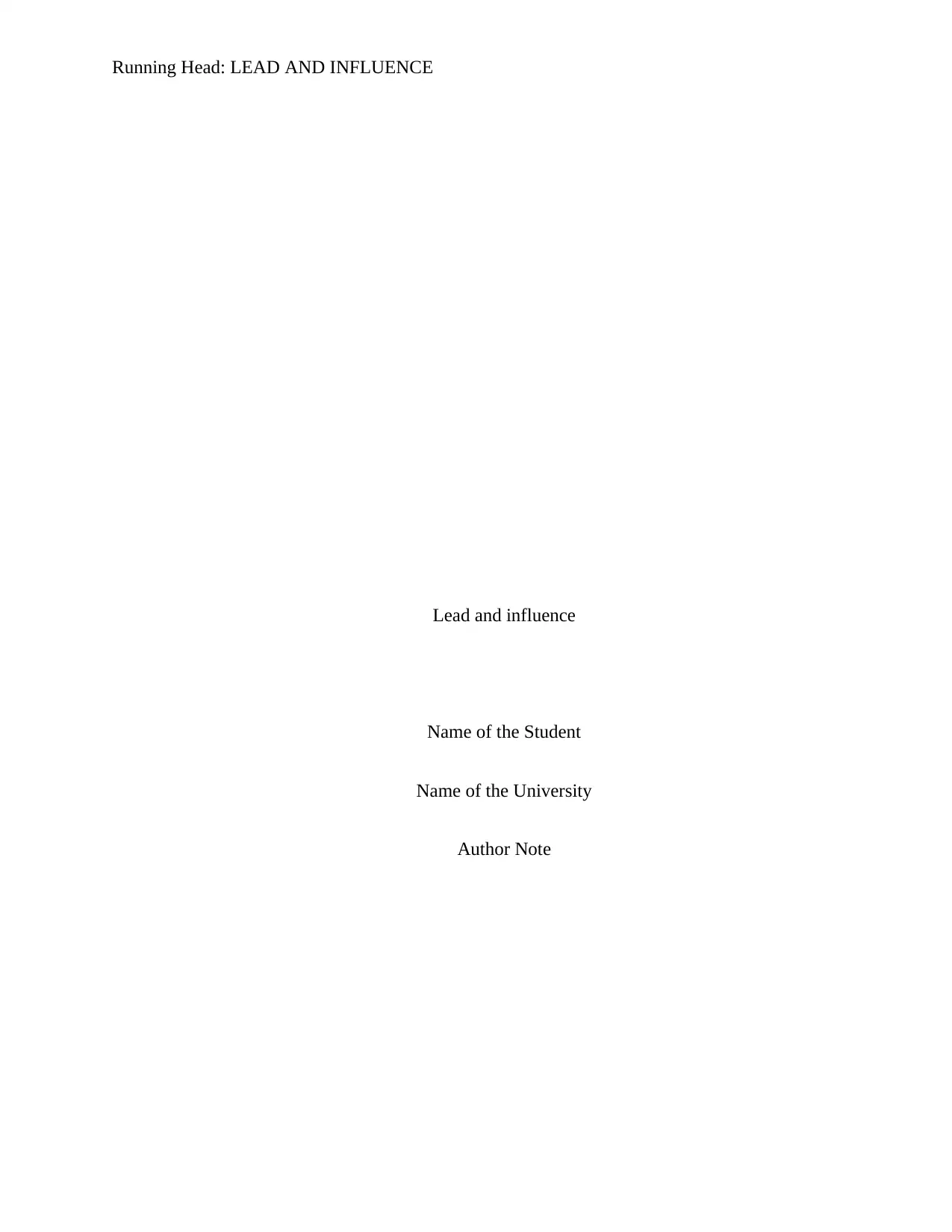
Running Head: LEAD AND INFLUENCE
Lead and influence
Name of the Student
Name of the University
Author Note
Lead and influence
Name of the Student
Name of the University
Author Note
Paraphrase This Document
Need a fresh take? Get an instant paraphrase of this document with our AI Paraphraser
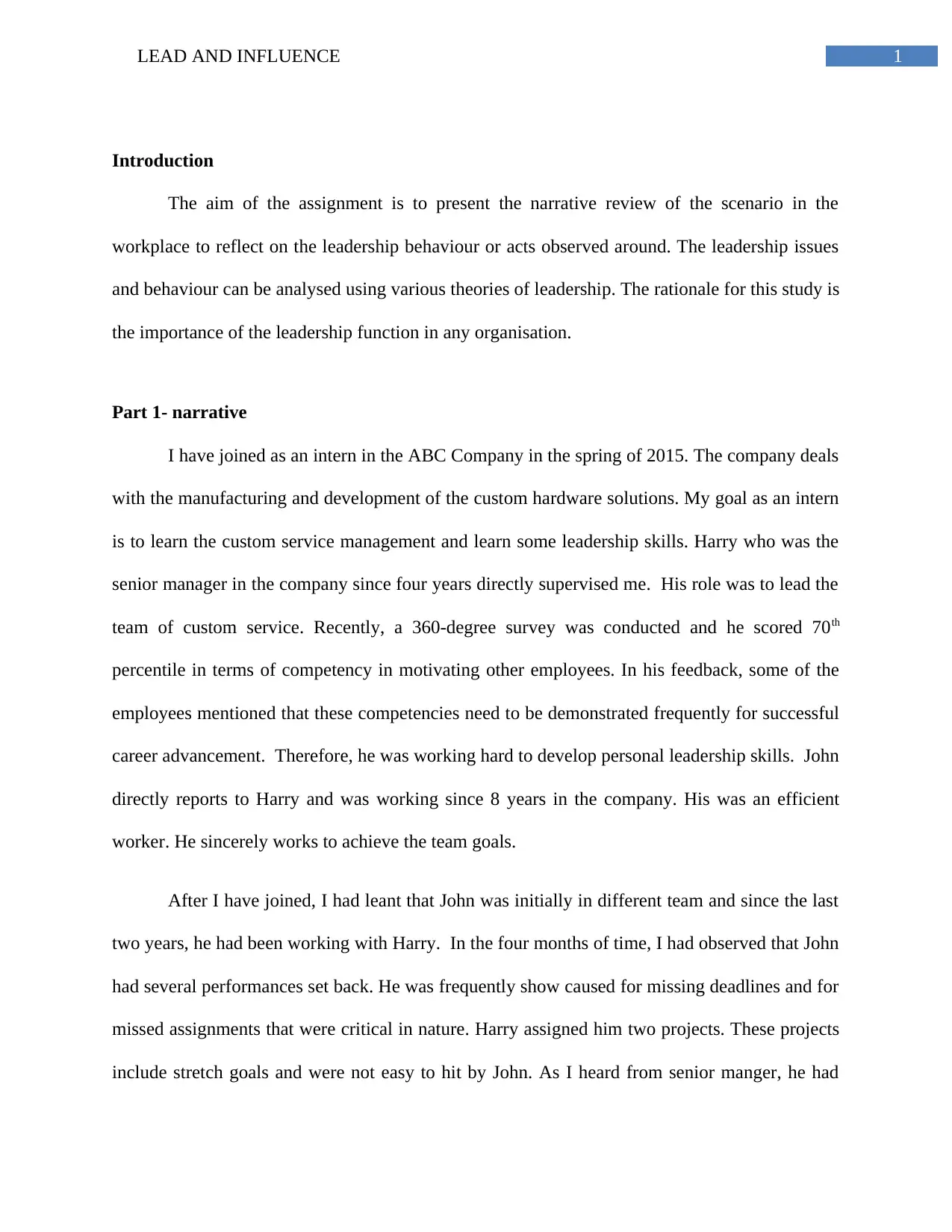
1LEAD AND INFLUENCE
Introduction
The aim of the assignment is to present the narrative review of the scenario in the
workplace to reflect on the leadership behaviour or acts observed around. The leadership issues
and behaviour can be analysed using various theories of leadership. The rationale for this study is
the importance of the leadership function in any organisation.
Part 1- narrative
I have joined as an intern in the ABC Company in the spring of 2015. The company deals
with the manufacturing and development of the custom hardware solutions. My goal as an intern
is to learn the custom service management and learn some leadership skills. Harry who was the
senior manager in the company since four years directly supervised me. His role was to lead the
team of custom service. Recently, a 360-degree survey was conducted and he scored 70th
percentile in terms of competency in motivating other employees. In his feedback, some of the
employees mentioned that these competencies need to be demonstrated frequently for successful
career advancement. Therefore, he was working hard to develop personal leadership skills. John
directly reports to Harry and was working since 8 years in the company. His was an efficient
worker. He sincerely works to achieve the team goals.
After I have joined, I had leant that John was initially in different team and since the last
two years, he had been working with Harry. In the four months of time, I had observed that John
had several performances set back. He was frequently show caused for missing deadlines and for
missed assignments that were critical in nature. Harry assigned him two projects. These projects
include stretch goals and were not easy to hit by John. As I heard from senior manger, he had
Introduction
The aim of the assignment is to present the narrative review of the scenario in the
workplace to reflect on the leadership behaviour or acts observed around. The leadership issues
and behaviour can be analysed using various theories of leadership. The rationale for this study is
the importance of the leadership function in any organisation.
Part 1- narrative
I have joined as an intern in the ABC Company in the spring of 2015. The company deals
with the manufacturing and development of the custom hardware solutions. My goal as an intern
is to learn the custom service management and learn some leadership skills. Harry who was the
senior manager in the company since four years directly supervised me. His role was to lead the
team of custom service. Recently, a 360-degree survey was conducted and he scored 70th
percentile in terms of competency in motivating other employees. In his feedback, some of the
employees mentioned that these competencies need to be demonstrated frequently for successful
career advancement. Therefore, he was working hard to develop personal leadership skills. John
directly reports to Harry and was working since 8 years in the company. His was an efficient
worker. He sincerely works to achieve the team goals.
After I have joined, I had leant that John was initially in different team and since the last
two years, he had been working with Harry. In the four months of time, I had observed that John
had several performances set back. He was frequently show caused for missing deadlines and for
missed assignments that were critical in nature. Harry assigned him two projects. These projects
include stretch goals and were not easy to hit by John. As I heard from senior manger, he had
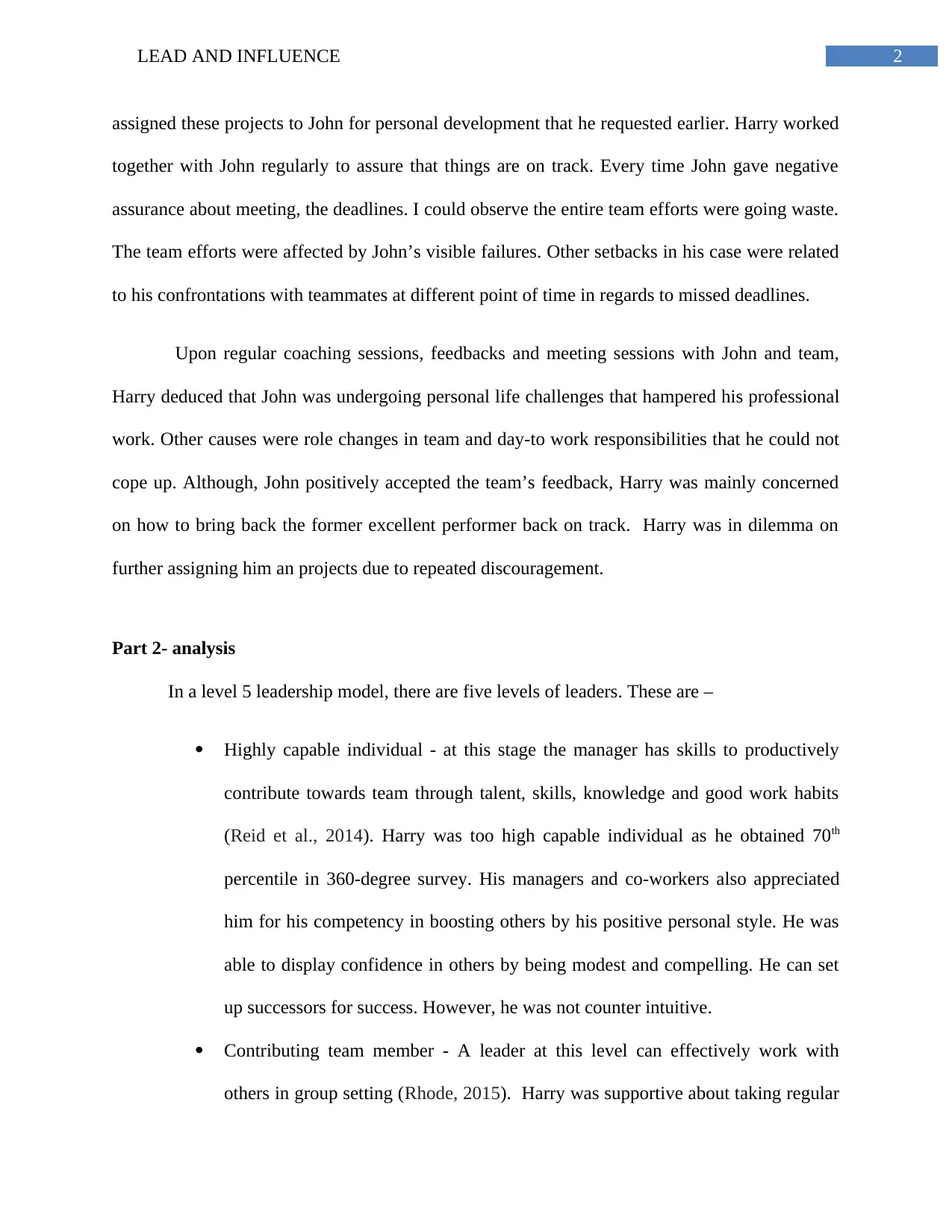
2LEAD AND INFLUENCE
assigned these projects to John for personal development that he requested earlier. Harry worked
together with John regularly to assure that things are on track. Every time John gave negative
assurance about meeting, the deadlines. I could observe the entire team efforts were going waste.
The team efforts were affected by John’s visible failures. Other setbacks in his case were related
to his confrontations with teammates at different point of time in regards to missed deadlines.
Upon regular coaching sessions, feedbacks and meeting sessions with John and team,
Harry deduced that John was undergoing personal life challenges that hampered his professional
work. Other causes were role changes in team and day-to work responsibilities that he could not
cope up. Although, John positively accepted the team’s feedback, Harry was mainly concerned
on how to bring back the former excellent performer back on track. Harry was in dilemma on
further assigning him an projects due to repeated discouragement.
Part 2- analysis
In a level 5 leadership model, there are five levels of leaders. These are –
Highly capable individual - at this stage the manager has skills to productively
contribute towards team through talent, skills, knowledge and good work habits
(Reid et al., 2014). Harry was too high capable individual as he obtained 70th
percentile in 360-degree survey. His managers and co-workers also appreciated
him for his competency in boosting others by his positive personal style. He was
able to display confidence in others by being modest and compelling. He can set
up successors for success. However, he was not counter intuitive.
Contributing team member - A leader at this level can effectively work with
others in group setting (Rhode, 2015). Harry was supportive about taking regular
assigned these projects to John for personal development that he requested earlier. Harry worked
together with John regularly to assure that things are on track. Every time John gave negative
assurance about meeting, the deadlines. I could observe the entire team efforts were going waste.
The team efforts were affected by John’s visible failures. Other setbacks in his case were related
to his confrontations with teammates at different point of time in regards to missed deadlines.
Upon regular coaching sessions, feedbacks and meeting sessions with John and team,
Harry deduced that John was undergoing personal life challenges that hampered his professional
work. Other causes were role changes in team and day-to work responsibilities that he could not
cope up. Although, John positively accepted the team’s feedback, Harry was mainly concerned
on how to bring back the former excellent performer back on track. Harry was in dilemma on
further assigning him an projects due to repeated discouragement.
Part 2- analysis
In a level 5 leadership model, there are five levels of leaders. These are –
Highly capable individual - at this stage the manager has skills to productively
contribute towards team through talent, skills, knowledge and good work habits
(Reid et al., 2014). Harry was too high capable individual as he obtained 70th
percentile in 360-degree survey. His managers and co-workers also appreciated
him for his competency in boosting others by his positive personal style. He was
able to display confidence in others by being modest and compelling. He can set
up successors for success. However, he was not counter intuitive.
Contributing team member - A leader at this level can effectively work with
others in group setting (Rhode, 2015). Harry was supportive about taking regular
⊘ This is a preview!⊘
Do you want full access?
Subscribe today to unlock all pages.

Trusted by 1+ million students worldwide
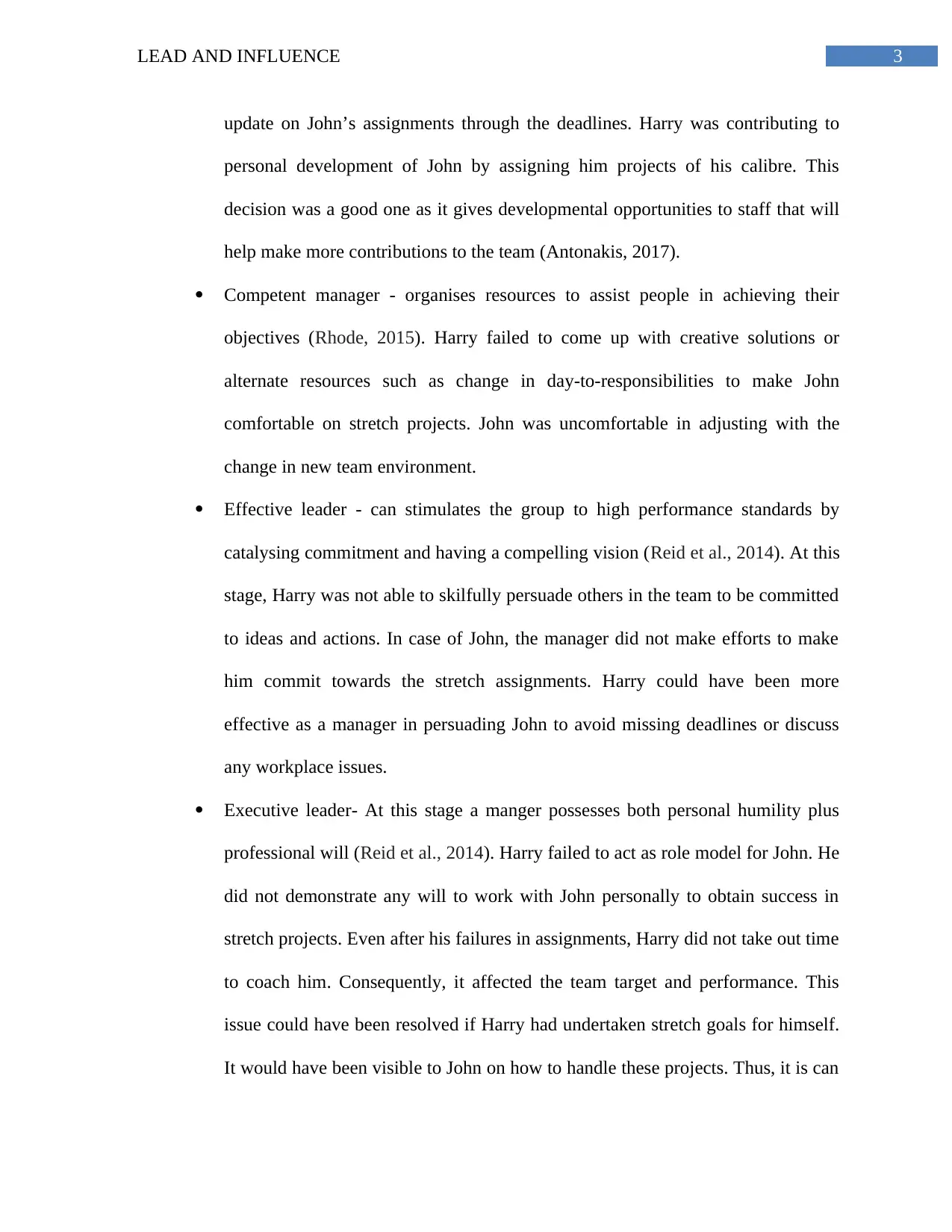
3LEAD AND INFLUENCE
update on John’s assignments through the deadlines. Harry was contributing to
personal development of John by assigning him projects of his calibre. This
decision was a good one as it gives developmental opportunities to staff that will
help make more contributions to the team (Antonakis, 2017).
Competent manager - organises resources to assist people in achieving their
objectives (Rhode, 2015). Harry failed to come up with creative solutions or
alternate resources such as change in day-to-responsibilities to make John
comfortable on stretch projects. John was uncomfortable in adjusting with the
change in new team environment.
Effective leader - can stimulates the group to high performance standards by
catalysing commitment and having a compelling vision (Reid et al., 2014). At this
stage, Harry was not able to skilfully persuade others in the team to be committed
to ideas and actions. In case of John, the manager did not make efforts to make
him commit towards the stretch assignments. Harry could have been more
effective as a manager in persuading John to avoid missing deadlines or discuss
any workplace issues.
Executive leader- At this stage a manger possesses both personal humility plus
professional will (Reid et al., 2014). Harry failed to act as role model for John. He
did not demonstrate any will to work with John personally to obtain success in
stretch projects. Even after his failures in assignments, Harry did not take out time
to coach him. Consequently, it affected the team target and performance. This
issue could have been resolved if Harry had undertaken stretch goals for himself.
It would have been visible to John on how to handle these projects. Thus, it is can
update on John’s assignments through the deadlines. Harry was contributing to
personal development of John by assigning him projects of his calibre. This
decision was a good one as it gives developmental opportunities to staff that will
help make more contributions to the team (Antonakis, 2017).
Competent manager - organises resources to assist people in achieving their
objectives (Rhode, 2015). Harry failed to come up with creative solutions or
alternate resources such as change in day-to-responsibilities to make John
comfortable on stretch projects. John was uncomfortable in adjusting with the
change in new team environment.
Effective leader - can stimulates the group to high performance standards by
catalysing commitment and having a compelling vision (Reid et al., 2014). At this
stage, Harry was not able to skilfully persuade others in the team to be committed
to ideas and actions. In case of John, the manager did not make efforts to make
him commit towards the stretch assignments. Harry could have been more
effective as a manager in persuading John to avoid missing deadlines or discuss
any workplace issues.
Executive leader- At this stage a manger possesses both personal humility plus
professional will (Reid et al., 2014). Harry failed to act as role model for John. He
did not demonstrate any will to work with John personally to obtain success in
stretch projects. Even after his failures in assignments, Harry did not take out time
to coach him. Consequently, it affected the team target and performance. This
issue could have been resolved if Harry had undertaken stretch goals for himself.
It would have been visible to John on how to handle these projects. Thus, it is can
Paraphrase This Document
Need a fresh take? Get an instant paraphrase of this document with our AI Paraphraser
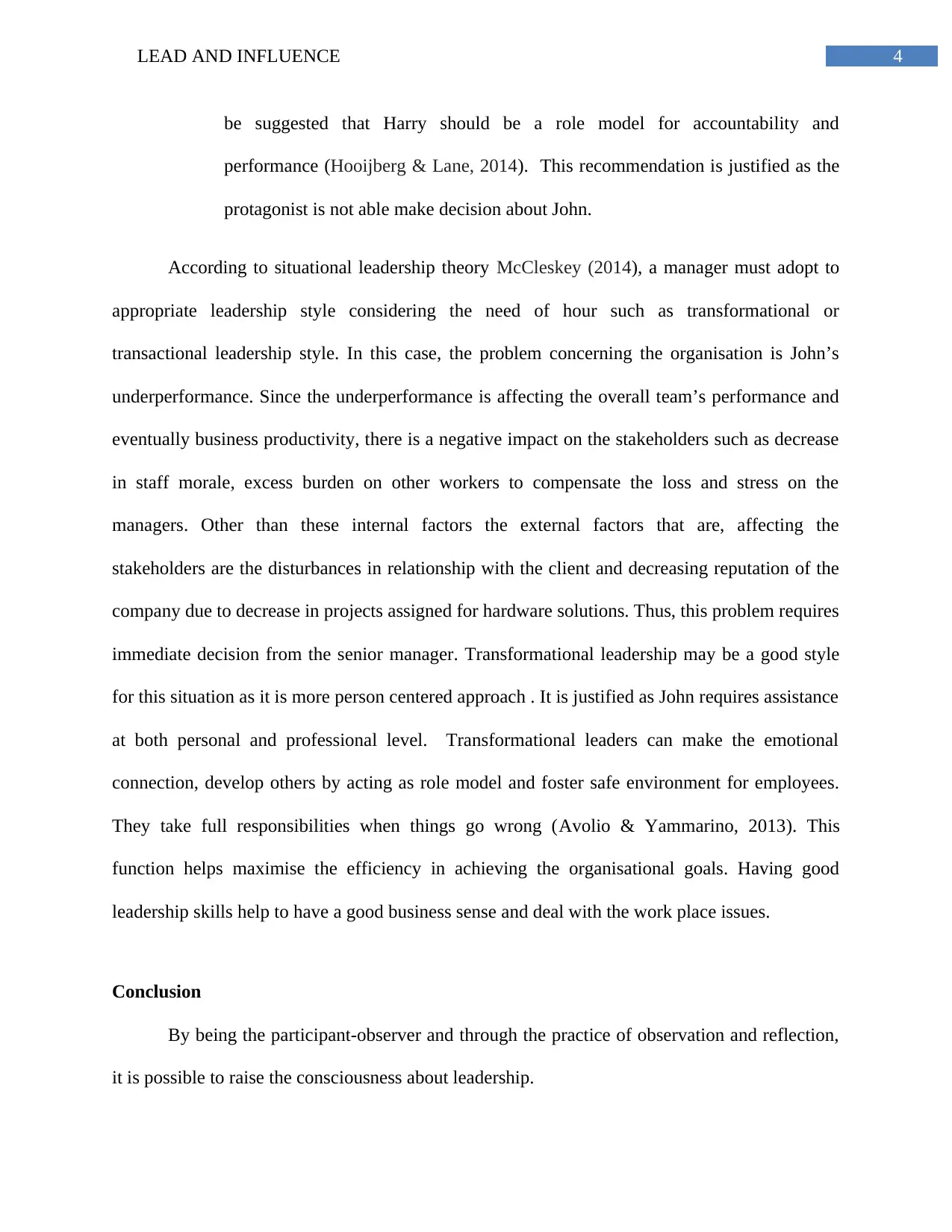
4LEAD AND INFLUENCE
be suggested that Harry should be a role model for accountability and
performance (Hooijberg & Lane, 2014). This recommendation is justified as the
protagonist is not able make decision about John.
According to situational leadership theory McCleskey (2014), a manager must adopt to
appropriate leadership style considering the need of hour such as transformational or
transactional leadership style. In this case, the problem concerning the organisation is John’s
underperformance. Since the underperformance is affecting the overall team’s performance and
eventually business productivity, there is a negative impact on the stakeholders such as decrease
in staff morale, excess burden on other workers to compensate the loss and stress on the
managers. Other than these internal factors the external factors that are, affecting the
stakeholders are the disturbances in relationship with the client and decreasing reputation of the
company due to decrease in projects assigned for hardware solutions. Thus, this problem requires
immediate decision from the senior manager. Transformational leadership may be a good style
for this situation as it is more person centered approach . It is justified as John requires assistance
at both personal and professional level. Transformational leaders can make the emotional
connection, develop others by acting as role model and foster safe environment for employees.
They take full responsibilities when things go wrong (Avolio & Yammarino, 2013). This
function helps maximise the efficiency in achieving the organisational goals. Having good
leadership skills help to have a good business sense and deal with the work place issues.
Conclusion
By being the participant-observer and through the practice of observation and reflection,
it is possible to raise the consciousness about leadership.
be suggested that Harry should be a role model for accountability and
performance (Hooijberg & Lane, 2014). This recommendation is justified as the
protagonist is not able make decision about John.
According to situational leadership theory McCleskey (2014), a manager must adopt to
appropriate leadership style considering the need of hour such as transformational or
transactional leadership style. In this case, the problem concerning the organisation is John’s
underperformance. Since the underperformance is affecting the overall team’s performance and
eventually business productivity, there is a negative impact on the stakeholders such as decrease
in staff morale, excess burden on other workers to compensate the loss and stress on the
managers. Other than these internal factors the external factors that are, affecting the
stakeholders are the disturbances in relationship with the client and decreasing reputation of the
company due to decrease in projects assigned for hardware solutions. Thus, this problem requires
immediate decision from the senior manager. Transformational leadership may be a good style
for this situation as it is more person centered approach . It is justified as John requires assistance
at both personal and professional level. Transformational leaders can make the emotional
connection, develop others by acting as role model and foster safe environment for employees.
They take full responsibilities when things go wrong (Avolio & Yammarino, 2013). This
function helps maximise the efficiency in achieving the organisational goals. Having good
leadership skills help to have a good business sense and deal with the work place issues.
Conclusion
By being the participant-observer and through the practice of observation and reflection,
it is possible to raise the consciousness about leadership.
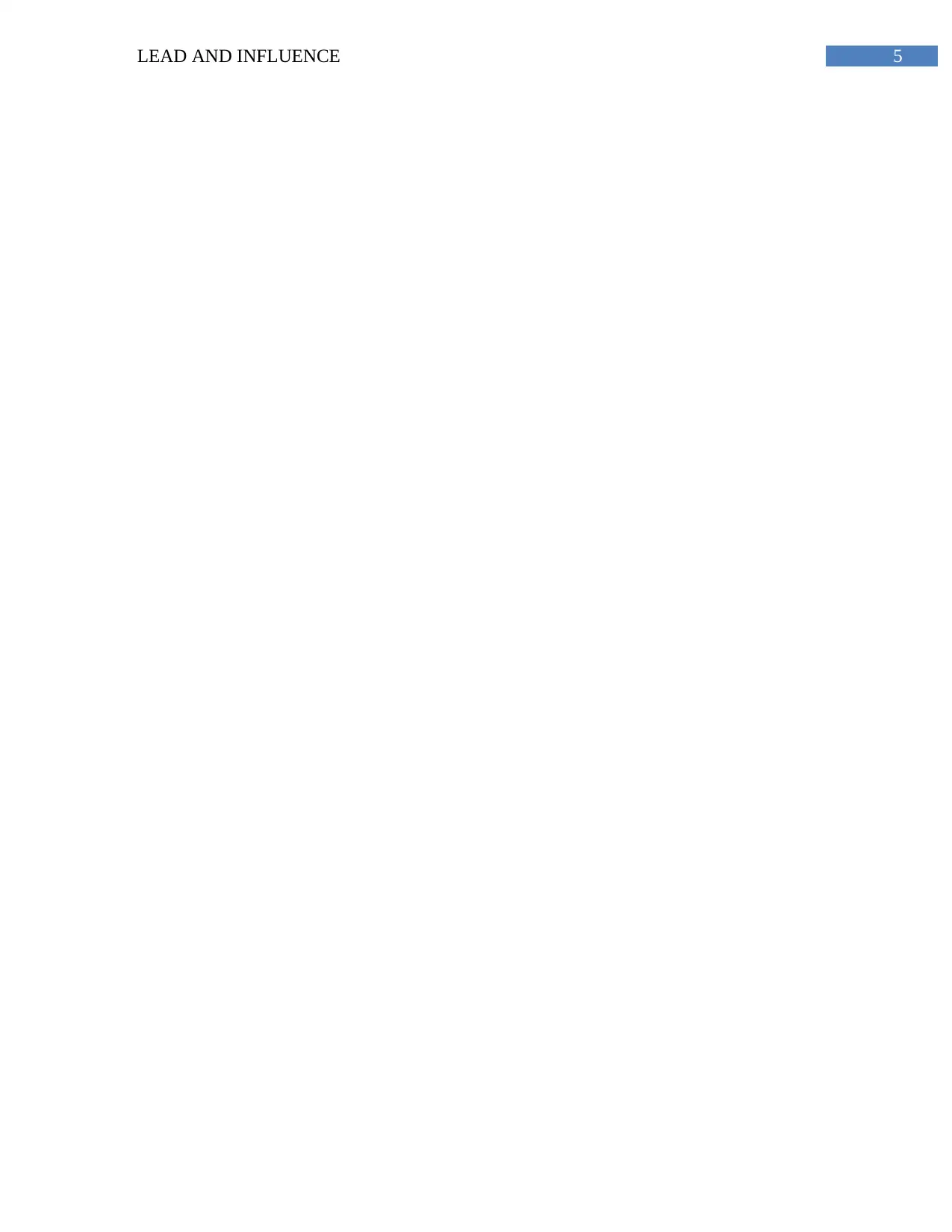
5LEAD AND INFLUENCE
⊘ This is a preview!⊘
Do you want full access?
Subscribe today to unlock all pages.

Trusted by 1+ million students worldwide
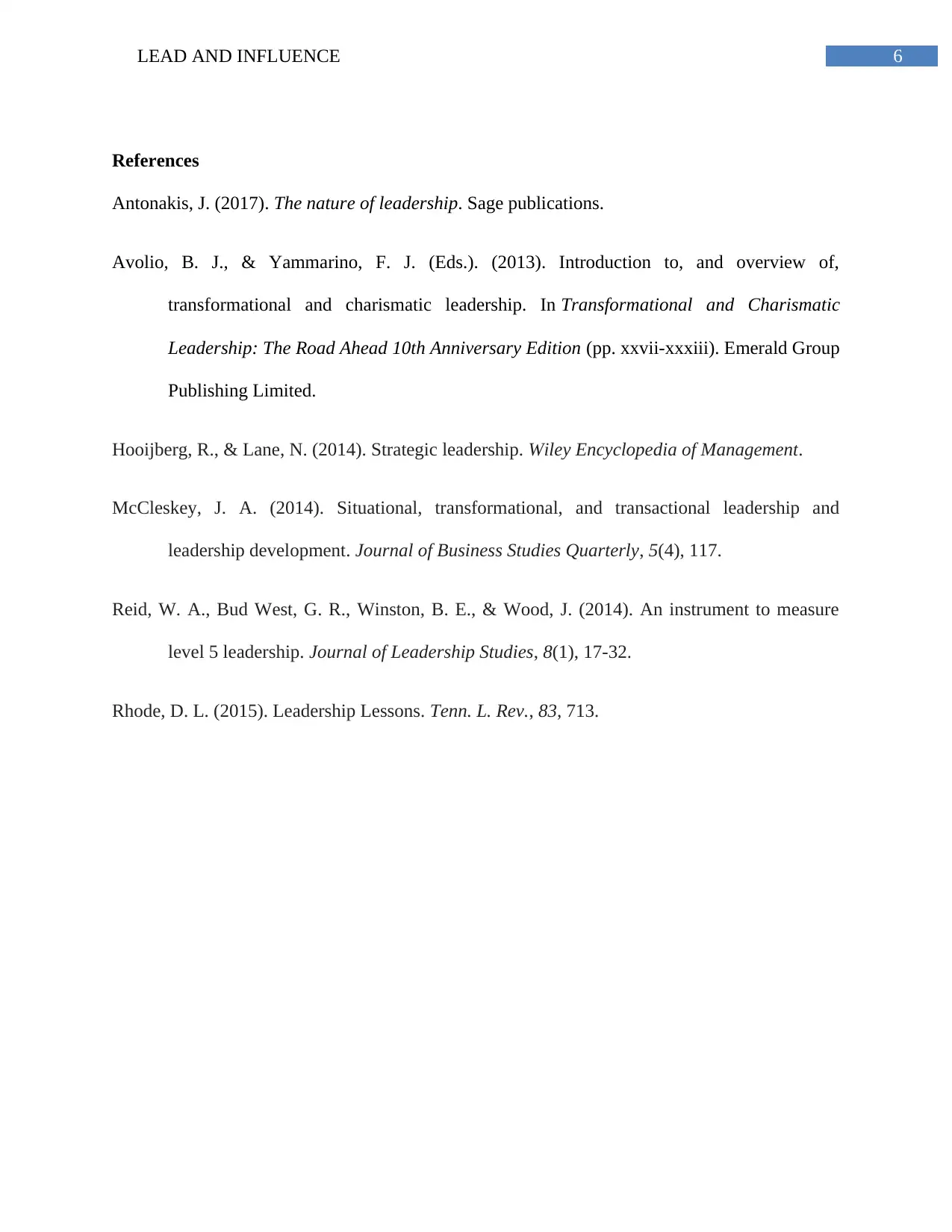
6LEAD AND INFLUENCE
References
Antonakis, J. (2017). The nature of leadership. Sage publications.
Avolio, B. J., & Yammarino, F. J. (Eds.). (2013). Introduction to, and overview of,
transformational and charismatic leadership. In Transformational and Charismatic
Leadership: The Road Ahead 10th Anniversary Edition (pp. xxvii-xxxiii). Emerald Group
Publishing Limited.
Hooijberg, R., & Lane, N. (2014). Strategic leadership. Wiley Encyclopedia of Management.
McCleskey, J. A. (2014). Situational, transformational, and transactional leadership and
leadership development. Journal of Business Studies Quarterly, 5(4), 117.
Reid, W. A., Bud West, G. R., Winston, B. E., & Wood, J. (2014). An instrument to measure
level 5 leadership. Journal of Leadership Studies, 8(1), 17-32.
Rhode, D. L. (2015). Leadership Lessons. Tenn. L. Rev., 83, 713.
References
Antonakis, J. (2017). The nature of leadership. Sage publications.
Avolio, B. J., & Yammarino, F. J. (Eds.). (2013). Introduction to, and overview of,
transformational and charismatic leadership. In Transformational and Charismatic
Leadership: The Road Ahead 10th Anniversary Edition (pp. xxvii-xxxiii). Emerald Group
Publishing Limited.
Hooijberg, R., & Lane, N. (2014). Strategic leadership. Wiley Encyclopedia of Management.
McCleskey, J. A. (2014). Situational, transformational, and transactional leadership and
leadership development. Journal of Business Studies Quarterly, 5(4), 117.
Reid, W. A., Bud West, G. R., Winston, B. E., & Wood, J. (2014). An instrument to measure
level 5 leadership. Journal of Leadership Studies, 8(1), 17-32.
Rhode, D. L. (2015). Leadership Lessons. Tenn. L. Rev., 83, 713.
1 out of 7
Related Documents
Your All-in-One AI-Powered Toolkit for Academic Success.
+13062052269
info@desklib.com
Available 24*7 on WhatsApp / Email
![[object Object]](/_next/static/media/star-bottom.7253800d.svg)
Unlock your academic potential
Copyright © 2020–2025 A2Z Services. All Rights Reserved. Developed and managed by ZUCOL.




